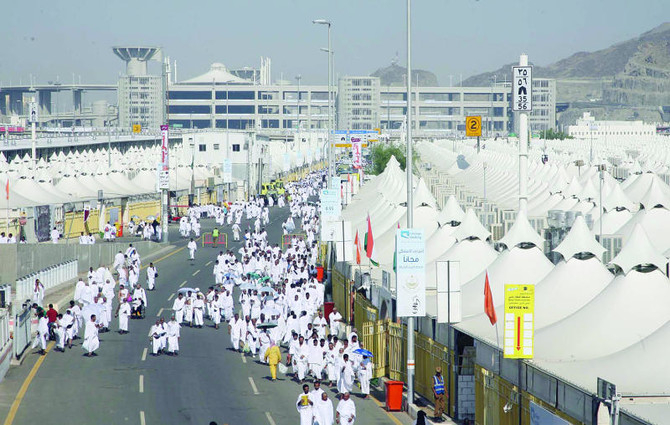The tent city of Mina remains deserted throughout the year. It comes to life only during the five days of each Haj season.
Situated 12 kilometers outside Makkah, it was in this city that Prophet Ibrahim (peace be upon him) spent the night before he was set to carry out an order by God to slaughter his son. As Prophet Ibrahim prepared to slaughter Ismaeel, God instructed him to sacrifice a sheep instead. Muslims around the world slaughter sheep, cows and camels to feed the poor marking Prophet Ibrahim’s supreme sacrifice.
Mina is a small city located inside a valley. As far as the eye can see, tents cover every open space. They are neatly arranged, row after row. It is because of these ubiquitous tents that the city is referred to as the tent city.
In the last two years, the city underwent a massive change with the government investing billions of riyals into many infrastructural projects to ease the daunting and physically demanding rituals of the annual pilgrimage.
Those who came here 30 years ago or even 10 years ago can barely recognize Mina as it stands today.
Ahmed Muhammad Al-Haj, a Sudanese pilgrim, vividly remembers how the city looked in 1980.
“The one dominant structure in those days was Masjid Al-Qaif, in the center of Mina,” he said. “All pilgrims would come straight to the mosque from Makkah.”
It was here that Al-Haj made many friends from across the world. “There were Pakistanis, Indians, Malaysians, Americans, all of them,” he said. “The tents were there but they were in such massive numbers and they were not arranged with such meticulous precision. There was a lot of open space.”
The Jamarat Bridge, where pilgrims carry out the symbolic ritual of stoning Satan, was more like a small pedestrian footbridge. “There was a ground floor and a first floor; it was very small, but quite sufficient for the number of Hajis who came in those days,” said Al-Haj. “As the number of pilgrims swelled into millions in later years, the bridge became a death trap.”
Maulana Maqbool Rahmani, from India, is performing Haj after a gap of nearly 17 years. He was here in 1997. “We call that the year of the blaze,” he said, referring to the massive fire that swept through the tent city killing nearly 350 pilgrims. “I was among those who survived.”
Rahmani is full of appreciation for the Saudi authorities. “The very next year, the Saudi government started putting up high-tech fire-resistant tents throughout the city,” he said.
Each tent is made of fiberglass coated with Teflon and a heat-sensitive water sprinkler, which is linked to an alarm system, and electric lighting. That changed the face of Mina. The tents were organized in a scientific way.
After the fire, the government was faced with other daunting challenge; That of conducting an orderly ritual of stoning the Satan.
“That was the biggest challenge because tragedies at the Jamarat Bridge became a norm,” said Abrar Siddiqui, a Jeddah-based Haj operator. “It was a logistical nightmare for the authorities.”
It was then decided to convert the pedestrian-looking bridge into a massive complex to avoid congestion. Billions were spent on constructing the multi-floor complex with multiple exits, water sprinklers and air-conditioning.
“Now, performing the ritual is a breeze,” said Siddiqui. “The project, executed by Saudi Bin Ladin Group, has a helipad to evacuate pilgrims in distress during rush-hours.”
Also, in what is described as a smart move, the throwing of stones was made much easier by changing the shape of the pillars that symbolize Satan. “They were round pillars in the past and pilgrims would strain and sometimes injure themselves taking a shot at them with their pea-sized pebbles,” said Siddiqui. “They would miss their mark and would repeat the ritual again and again leading to catastrophes.”
The shape of the pillars was changed from round to elliptical. “As you approach them, they are now more like a V-shaped wall. And it is very easy to stone them,” said Siddiqui.
Once the tents and the bridge was taken care of, the government shifted its attention to organizing the chaotic transportation issue.
“Since all the pilgrims had to move from Makkah to Mina to Arafat and back to Muzdalifa and Mina, it would result in a logjam,” said Yasser Al-Qahtani, a television journalist. “Pilgrims would spend hours upon hours in their buses just to reach Muzdalifa and Mina from Arafat, a distance of mere 5 km.”
Despite constructing dozens of roads, there would still be traffic jams on the important day of Haj.
“That is when the government decided to introduce the Haj train,” said Al-Qahtani. “That resulted in taking the strain off the roads. Now, the Haj metro ferries thousands of pilgrims to Arafat from Mina and back.”
The Haj train added a dimension to the city. For first-time pilgrims it is nothing short of wonderment to see trains whizzing by on the elevated tracks in the tent city.
Rifat Anjum, a longtime Jeddah expat, said she performed Haj in 2000. “We were part of the Haj caravan organized by a Jeddah Haj operator. “We did not stay in a camp in those days; we were actually housed in a building located close to the Jamarat Bridge. On Jamarat day, we would actually look out from our building to see if the crowd was dense on the bridge,” she said.
All those buildings are now gone. The old city of MIna is now replaced by a modern city with massive health facilities, state-of-the-art slaughterhouses, over-bridges, pedestrian walkways and elevated train stations.
A massive change for Mina in 30 years
A massive change for Mina in 30 years











